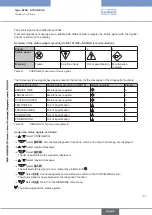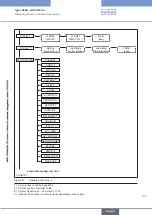
137
Auxiliary functions
Type 8792, 8793 REV.2
STROKE.CHECK
– End position monitor
The
STROKE.CHECK
function is used to monitor the physical end positions of the valve. In this way wear
marks can be detected on the valve seat.
To do this, a tolerance band is specified for the lower end position (position 0%) and for the upper end position
(position 100%). If an end position exceeds or falls below the tolerance band, a message is output.
•
To do this, a history entry is made in the
HISTORY
submenu. For a description see “26.2.22.7. History
entries in the HISTORY submenu”.
•
The status signal, which is assigned to the message, is indicated at short intervals on the display.
See also
D.MSG
and
CONFIG.MSG
in chapter “26.2.22.5” on page 158.
In addition to the monitor there is an end position slave pointer. This indicates the minimum and maximum
position of the determined end positions. The slave pointer can be reset by pressing the
CLEAR
key.
Display
STROKE.CHECK
Description of the functions
EXIT
29-9-1
STROKE.CHECK
MAX
MIN
LIMIT
HISTORY
30. 9%
67.6%
MAX
indicates the maximum position of the slave pointer
MIN
indicates the minimum position of the slave pointer.
The tolerance band for the physical end positions can be set in the
LIMIT
submenu. A message is output if the temperature goes outside
the permitted range.
Example:
Input upper end position
TOL MAX
= 1%
If the position is less than -1%, a message is output
Input lower end position
TOL ZERO
= 1%
If the position is greater than 101%, a message is output
The history entries of the last 3 messages can be viewed and deleted in
the
HISTORY
submenu.
Table 47:
STROKE.CHECK; end position monitor
If a stroke limit was set in the
X.LIMIT
menu, the mechanical end position monitor has only limited
relevance.
The end positions indicated on the process level under
POS
are not the physically caused end
positions in this case. Therefore they cannot be compared with the end positions indicated in the
STROKE.CHECK
menu under
MIN
and
MAX
.
Specify the Position limit for outputting messages as follows:
→
/ Select
STROKE.CHECK
.
(To do this, the
STROKE.CHECK
function must be incorporated into the
DIAGNOSE
main menu. See
chapter “16.1.24.3. Activation of diagnostic functions”).
→
Select
ENTER
. The menus are displayed.
→
/ Select
LIMIT
.
→
Select
ENTER
.
The submenus for inputting the lower and upper end position tolerance are displayed.
The submenu for inputting the lower end position tolerance
ZERO.TOL
has already been selected.
→
Select
INPUT
. Open input screen for lower end position tolerance.
→
/
+
Increase value
<-
Changing the decimal place
english





































